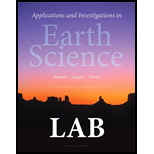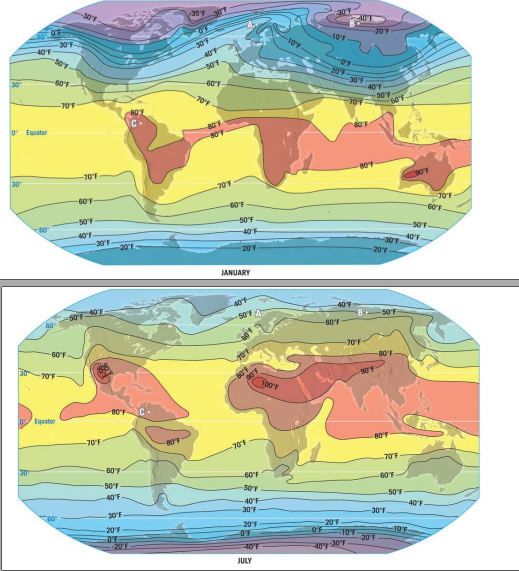
Applications and Investigations in Earth Science Plus Mastering Geology with eText -- Access Card Package (8th Edition)
8th Edition
ISBN: 9780321934536
Author: Edward J. Tarbuck, Frederick K. Lutgens, Dennis G. Tasa, Kenneth G. Pinzke
Publisher: PEARSON
expand_more
expand_more
format_list_bulleted
Textbook Question
Chapter 13.6, Problem 2A
In general, how do surface temperatures vary from the equator toward the poles? What is the likely cause of this variation?

Expert Solution & Answer
Trending nowThis is a popular solution!
Learn your wayIncludes step-by-step video

schedule09:29
Students have asked these similar questions
1. Complete the block diagram in Figure 6.20 by drawing a left-lateral fault on Part B.
2. Draw arrows on both sides of the fault in Figure 6.20B to illustrate the relative motion of each block.
On each of the block diagrams in Figure 6.16, determine the relative ages of the surface rocks on both sides of the fault trace (after erosion) and write the word older or younger on the appropriate side of each fault trace.
Complete Figure 6.18 by illustrating an eroded reverse fault on Part B. Place arrows on both sides of the fault to illustrate relative motion.
Chapter 13 Solutions
Applications and Investigations in Earth Science Plus Mastering Geology with eText -- Access Card Package (8th Edition)
Ch. 13.1 - Prob. 1ACh. 13.1 - Which part color of visible light has the shortest...Ch. 13.1 - Which part of the electromagnetic...Ch. 13.2 - Prob. 1ACh. 13.2 - Does solar radiation that is reflected and...Ch. 13.2 - What percentage of incoming solar radiation is...Ch. 13.2 - What percentage of incoming solar radiation passes...Ch. 13.2 - Excluding the radiation that is reflected and...Ch. 13.3 - Prob. 1ACh. 13.3 - Does Earths surface emit ultraviolet, visible, or...
Ch. 13.3 - Is nitrogen, the most abundant constituent of the...Ch. 13.3 - Which two gases are most effective in absorbing...Ch. 13.3 - Prob. 5ACh. 13.4A - Write a statement that summarizes the results of...Ch. 13.4A - Prob. 3ACh. 13.4A - Prob. 4ACh. 13.4A - Prob. 5ACh. 13.4B - Prob. 1ACh. 13.4B - Prob. 2ACh. 13.4B - Prob. 3ACh. 13.4B - Prob. 4ACh. 13.4B - Which city has the highest monthly mean...Ch. 13.4B - Which city has the lowest monthly mean...Ch. 13.4B - Which city has the greatest annual temperature...Ch. 13.4B - Which city reaches its maximum monthly mean...Ch. 13.4B - Which city maintains more uniform temperatures...Ch. 13.4B - Which city is along the west coast, and which city...Ch. 13.5 - Prob. 1ACh. 13.5 - At what time does the warmest temperature occur?Ch. 13.5 - What is the daily temperature range difference...Ch. 13.5 - What is the daily mean temperature average of the...Ch. 13.5 - Why does the coolest temperature of the day occur...Ch. 13.5 - How would cloud cover influence the daily maximum...Ch. 13.5 - How would cloud cover influence the daily minimum...Ch. 13.5 - Prob. 8ACh. 13.6 - Prob. 1ACh. 13.6 - In general, how do surface temperatures vary from...Ch. 13.6 - Prob. 3ACh. 13.6 - Calculate the annual temperature range along the...Ch. 13.6 - Explain the wide annual range of temperatures in...Ch. 13.6 - Why is the annual temperature range smaller along...Ch. 13.6 - Compare the average monthly temperatures for...Ch. 13.6 - Prob. 8ACh. 13.6 - Trace the path of the 40F isotherm over North...Ch. 13.6 - Trace the path of the 70F isotherm over North...Ch. 13.6 - Why do the isotherms in the Southern Hemisphere...Ch. 13.6 - Explain why the entire pattern of isotherms has a...Ch. 13.7 - Prob. 1ACh. 13.7 - Prob. 2ACh. 13 - Prob. 1LRCh. 13 - How should an increase in the amount of carbon...Ch. 13 - Prob. 3LRCh. 13 - Briefly explain how Earths atmosphere is heated.Ch. 13 - Name the two gases that absorb most of Earths...Ch. 13 - Prob. 7LRCh. 13 - In general, do land surfaces heat more or less...Ch. 13 - At what locations continent or marine do we find...Ch. 13 - Why do the middle to high latitudes of the...Ch. 13 - Prob. 12LR
Additional Science Textbook Solutions
Find more solutions based on key concepts
Ingredient list of some common household products such as shampoo, lotion or cleanser must be examined and the ...
Living By Chemistry: First Edition Textbook
Heat lamps are commonly used to maintain foods at about 50C for as long as 12 hours in cafeteria serving lines....
Microbiology: An Introduction
All of the following terms can appropriately describe humans except: a. primary consumer b. autotroph c. hetero...
Human Biology: Concepts and Current Issues (8th Edition)
14. Steel nails are rigid and unbending. Steel wool is soft and squishy. How would you account for this differe...
College Physics: A Strategic Approach (3rd Edition)
APPLY 1.2 Express the following quantities in scientific notation
using fundamental SI units of mass and lengt...
Chemistry (7th Edition)
4. Two of these organ system bear the major responsibility for ensuring homeostasis of the internal environment...
Human Anatomy & Physiology (Marieb, Human Anatomy & Physiology) Standalone Book
Knowledge Booster
Similar questions
- Prompt: Using a visual art medium of your choice, please describe or explore any environmental issue or topic of your choice. Please ensure 100% human donearrow_forwardPrompt: Using a visual art medium of your choice, please describe or explore any environmental issue or topic of your choice. Please ensure 100% human donearrow_forwardPrompt: Using an online art style of your choice, please make a meme related to the study of Geography, Environment, or Geomatics. Please ensure 100% human donearrow_forward
- Using a visual art medium of your choice, please describe or explore any environmental issue or topic of your choice.arrow_forwardUsing an online art style of your choice, please make a meme related to the study of Geography, Environment, or Geomatics.arrow_forwardidentify the 2 rocks in the photoarrow_forward
- Draw several strike-dip symbols on Figure 6.14 that would be appropriate for a dome and a basin, respectively.arrow_forwardChoose two vehicles to compare. One being a gas powered one being electric. No hybrids. With the media of your choosing compare and contrast the two vehicles emissions and pollution factors. Key words are Hydrocarbon, Carbon, Hydrogen, Asthma, Infection, Pollution, and Global warming.arrow_forwardEvaluate the advantages and disadvantages of gas and electric cars.arrow_forward
- charles darwin, what did he doarrow_forwardWhile Chapters 8 and 9 consider almost purely endogenic processes, Chapter 10 takes us further out from the center of the Earth to exogenic processes. My sister and I were out for a walk when we decided to cut through the cemetery. I could not help but wonder why the tombstones below are so different. While both tombstones are roughly the same age, the top one is made out of limestone while the bottom one is made out of granite. However, the one above looks much older due to a difference in the rate of weathering. Limestone is made out of the mineral calcite, CaCO3, calcium carbonate. Reads "1884" Dieds JOSEPH HERRING 1842-1911 JULIA HERRING 1843 NELLIE HERRING 1870-1882 Reads "1882" The tombstone in better condition here is made out of granite. Granite contains minerals such as quartz and feldspar. Both tombstones experience the same climate conditions and have been exposed to exogenic processes for the same amount of time yet they look so different! Some research into Chapter 10…arrow_forwardDiscussion Question: Tectonics, Earthquakes and Volcanism A+ The image below can also be found in your textbook. This image is not an interpretation but an actual picture of the Red Sea. This area of the world is the East African Rift Zone separating Saudi Arabia and Africa. The linear pattern is due to extensional tectonics. In other words, Africa and Saudi Arabia are moving away from each other creating tensional forces that create normal faults. The landscape features found in the area are Rift Valleys. Pretend we are on location at the East African Rift Valley. We would find Normal Faults where one side of the fault shows a rock layer dropped relative to the other layer. We would find linear mountains that formed from the valley dropping out between the normal faults. The microscale evidence we collect helps to add up to the macroscale interpretation of a divergent boundary due to tensional forces creating normal faults and rift valleys.arrow_forward
arrow_back_ios
SEE MORE QUESTIONS
arrow_forward_ios
Recommended textbooks for you
 Applications and Investigations in Earth Science ...Earth ScienceISBN:9780134746241Author:Edward J. Tarbuck, Frederick K. Lutgens, Dennis G. TasaPublisher:PEARSON
Applications and Investigations in Earth Science ...Earth ScienceISBN:9780134746241Author:Edward J. Tarbuck, Frederick K. Lutgens, Dennis G. TasaPublisher:PEARSON Exercises for Weather & Climate (9th Edition)Earth ScienceISBN:9780134041360Author:Greg CarbonePublisher:PEARSON
Exercises for Weather & Climate (9th Edition)Earth ScienceISBN:9780134041360Author:Greg CarbonePublisher:PEARSON Environmental ScienceEarth ScienceISBN:9781260153125Author:William P Cunningham Prof., Mary Ann Cunningham ProfessorPublisher:McGraw-Hill Education
Environmental ScienceEarth ScienceISBN:9781260153125Author:William P Cunningham Prof., Mary Ann Cunningham ProfessorPublisher:McGraw-Hill Education Earth Science (15th Edition)Earth ScienceISBN:9780134543536Author:Edward J. Tarbuck, Frederick K. Lutgens, Dennis G. TasaPublisher:PEARSON
Earth Science (15th Edition)Earth ScienceISBN:9780134543536Author:Edward J. Tarbuck, Frederick K. Lutgens, Dennis G. TasaPublisher:PEARSON Environmental Science (MindTap Course List)Earth ScienceISBN:9781337569613Author:G. Tyler Miller, Scott SpoolmanPublisher:Cengage Learning
Environmental Science (MindTap Course List)Earth ScienceISBN:9781337569613Author:G. Tyler Miller, Scott SpoolmanPublisher:Cengage Learning Physical GeologyEarth ScienceISBN:9781259916823Author:Plummer, Charles C., CARLSON, Diane H., Hammersley, LisaPublisher:Mcgraw-hill Education,
Physical GeologyEarth ScienceISBN:9781259916823Author:Plummer, Charles C., CARLSON, Diane H., Hammersley, LisaPublisher:Mcgraw-hill Education,

Applications and Investigations in Earth Science ...
Earth Science
ISBN:9780134746241
Author:Edward J. Tarbuck, Frederick K. Lutgens, Dennis G. Tasa
Publisher:PEARSON

Exercises for Weather & Climate (9th Edition)
Earth Science
ISBN:9780134041360
Author:Greg Carbone
Publisher:PEARSON

Environmental Science
Earth Science
ISBN:9781260153125
Author:William P Cunningham Prof., Mary Ann Cunningham Professor
Publisher:McGraw-Hill Education

Earth Science (15th Edition)
Earth Science
ISBN:9780134543536
Author:Edward J. Tarbuck, Frederick K. Lutgens, Dennis G. Tasa
Publisher:PEARSON

Environmental Science (MindTap Course List)
Earth Science
ISBN:9781337569613
Author:G. Tyler Miller, Scott Spoolman
Publisher:Cengage Learning

Physical Geology
Earth Science
ISBN:9781259916823
Author:Plummer, Charles C., CARLSON, Diane H., Hammersley, Lisa
Publisher:Mcgraw-hill Education,